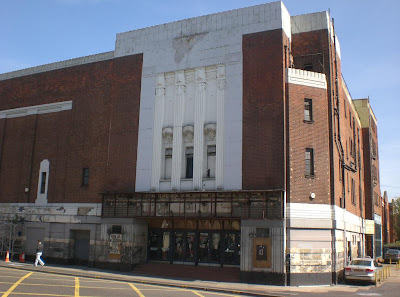June 20, 2013
MARINE BOY (1966) - series finally hitting DVD in US
Warner Archives have released the early anime series Marine Boy. The story of a young underwater action hero had monsters, sci-fi and a non-stop pace. While the US also had Japanese animation like Astro-Boy and Speed Racer, Marine Boy was the first anime series on British TV, the only one for many years.
The first (of three) seasons is now on sale from the Warner Archive website.
More about Marine Boy here.
June 16, 2013
My local cinemas of the 1970s - Ewell and Esher
(Once again, I'm in debt to Dusashenka on Flickr, for permission to use his old photos of these cinemas, inside and out. Please do not re-use any of them without seeking his permission first. He's contactable via his Flickr account.)
This article follows on from My Local Cinemas of the 1970s in Kingston.
In the 1970s, while Kingston's cinemas were conveniently on a direct bus route from my home, and just round the corner from school, other cinemas in the area would often run different movies, or with different supporting films. Also, if I'd missed any, a movie might still be playing in another town the following week. So I'd cycle up some horrendously busy 'A' roads to get to these two...
ABC Ewell
This was slightly smaller than the Kingston Granada and had been subdivided into only two screens. Again it retained its original main screen, now viewed only from the circle, as ABC 1. Under the circle, the stalls were walled off to become a sideways, shoebox-shaped, smaller screen, ABC 2.
Sited just next to where the Kingston Road dips under a railway bridge and becomes the Ewell Bypass. This had a huge car park round the back, but not many things to chain a bicycle to!
 |
| The view from the circle in Ewell's ABC 1 |
 |
| Upstairs entrance to the circle, ABC 1 |
 |
| Ticket office, just inside the main doors |
 |
| Site of the ABC Ewell, as it looks now |
Here's Derek Phillips' webpage dedicated to the history of The Rembrandt Cinema which became the ABC Ewell.
More information on the ABC Ewell in Cinema Treasures.
Embassy Esher
Like the Ewell ABC, the Embassy Esher had also been divided into two cinemas. I remember the seats as being especially comfortable for the time.
 |
| View from the circle, that became Embassy 1 |
Of all my local cinemas from the 1970s, this is the only one that's still going. It's now an Odeon, but the Embassy brickwork is still clearly visible (below).
As it looks now, still at 22, Esher High Street
June 12, 2013
My local cinemas of the 1970s - Kingston
The local cinemas of Kingston-on-Thames in the 1970s, how they look now, and how to find photos of your own favourite cinemas...
(In this article, the present-day photos are mine, all the older photographs are courtesy of Dusashenka's Flickr account, which I've gained permission directly to use here.)
 |
| Kingston's old Odeon - now the site of the Rose Theatre |
For an intensive period, roughly 1973 to 1983, I went to the movies every week. Huge screens and immersive experiences, often shared with a packed audience, left many indelible memories. Forty years later, I'm able to watch again most of the films that I enjoyed back then. But they were only part of the experience.
Thinking more about the cinemas themselves, I realised I'd no photographs of them, and my memories were fuzzy. At the time, photography was expensive and I didn't own a camera (not until I was 18). While omnipresent digital cameras can capture every moment of our lives now, I have barely a dozen photographs of myself during that entire decade! I'd certainly not go around photographing places that would still be there the following week. But eventually, they weren't there any more.
While researching cinemas that I'd visited in Miami in the summer of 1978 (for this article - Two Weeks, Eight Movies), I found the Cinema Treasures website, which is attempting to catalogue every movie house that ever existed in the USA. Ambitiously, it's also trying to list all those of other countries, and through the site I found invaluable information about closed cinemas.
Most important was this Flickr account, under the account name Dusashenka, a member who's been photographing cinemas and other British buildings for decades. Crucially, he's also uploaded the best of his father's similar archives, which stretch back even further. Once again, I could see inside cinemas that no longer exist.
Odeon Kingston
This is the old Kingston Odeon, not the new multiplex (more on that later). It was down Kingston High Street near the river, facing the Police Station. While I was living in the area, this was the first cinema to close, in 1967. I have a vague memory of going there, but only really remember it as the bingo hall it then became. It's now the site of the Rose Theatre.
More information about the old Odeon in Cinema Treasures.
ABC Kingston
This was a super cinema. The largest screen the town ever had. Near Kingston Station, if you just ducked under the railway bridge, at the start of the Richmond Road there was the ABC.
 |
| The ABC cinema was the big building behind the bridge. The view from Kingston Station, then and now. |
I can't remember the circle ever being open and the view from the stalls were hampered by a long, low rake. The seats barely sloped towards the screen, so even as a tall teenager it was easy to have your view of the screen blocked by the person in front.
The ABC resisted the urge to subdivide into smaller screens, but gave into the Dark Side (bingo) in July, 1976. While bingo is clearly inferior to cinema, at least the new owners ensured that the majority of the building remained unchanged for several decades. The vast scale of the interior can be seen in the photos on this bingo hall site.
 |
| From cinema to empty shell |
 |
| The main entrance looking very sad |
Bingo closed in 2010 and a new owner started destroying the interior. The exterior remains, unused. Above photo taken in 2011.
More information about the ABC in Cinema Treasures.
Studio 7 Kingston
A short walk from the ABC, diagonally opposite Kingston Station stood the Studio 7. Kingston's very own fleapit, a term now romantically Americanised as grindhouse. It was in fact a very old cinema that'd had a minimum of modernisation, like sound-proofing (it used to be a silent cinema).
The inadequate mono speaker distorted any of the movies' dialogue, which also had to compete with the bus station on one side and the one-way system on the other. Indeed, the flimsy fire exits down the lefthand aisle were all that separated us from the road. I remember not understanding a single word of Gone In Sixty Seconds (1974).
I only ventured up into the Studio 7 circle if the stalls were full, which they often were at weekends. The circle was quite small and set right at the back of the shoebox-shaped auditorium. A fairly rowdy cinema, this would be the place to get something dropped down your neck from a prankster in the circle. It was also the least robust-looking cinema I've ever been in. The climax of Matinee (1993) reminded me of the Studio 7.
Also inherited from it's early use as a church hall, was the completely flat floor of the stalls. Combined with a relatively low screen, this meant not being able to see the lower part of the screen if there was someone sat in front.
Despite all these disadvantages, I often went to the Studio 7 because of what was shown there. It would proudly play horror films, lots of them. This was why it was so often crowded out. I saw Friday the 13th (1980) there, a sellout performance on a Saturday night. Horror films play better if there's lots of screaming. I first saw Suspiria there on a double-bill with It's Alive sequel It Lives Again (another film I couldn't hear any of the dialogue).
Studio 7 rarely got A-list pictures until they were on their second time around. I saw Woody Allen's Sleeper on a double-bill with Return of the Pink Panther there, both as re-runs.
I'd moved away in 1980 and sadly missed the closure of the cinema in 1983, returning to discover it was now called Pine World. In 2000, the building was demolished and the site is now, fittingly, the only cinema in town. Or rather, 14 cinemas - the new Kingston Odeon, in this complex...
More information and an earlier photo of Studio 7 in Cinema Treasures.
Looking for photos, I was totally astonished to find that it's now available as a custom-made model kit! Your very own little Studio 7, intended to extend the diorama of Kingston's old bus garage which stood next door. This photo made me look twice though! Kingsway Models offer these flat-packed, so that you can make them up yourself, or they'll construct them for you if you're prepared to visit in person.
Kingsway Models offer many card dioramas of London Underground stations and bus Garages. They also offer these few cinemas.
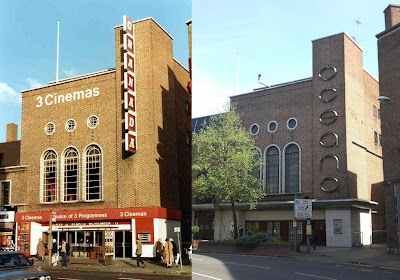 |
| Left: Granada in the 1980s. Right: the same building, 2011. |
Granada Kingston
OK, this was my favourite cinema. Three different continuous programmes, often all double-bills, every week. Steep seating, a big screen, the most modernised cinemas in Kingston at the time. Tight legroom but fairly comfy seats.
This photoset was a thrill, because it also shows what it was like inside. There were sometimes twenty minutes or more between films and I spent a lot of time staring at the huge chandelier in Granada 1. I'd forgotten what it looked like.
I have a vague memory of visiting the Granada when it had just one screen. But like many cinemas in this decade, the space beneath the circle was converted into two mini cinemas, side by side. The remainder of the stalls was still visible from up in the circle (the seats had been removed), which became Granada 1. Thankfully, the huge original screen was retained after the 1973 conversion.
This also meant that the Wurlitzer (that lived under the front of the stalls) remained accessible and in operation. As I discovered to my surprise before a performance of The Omen. I love this photo.
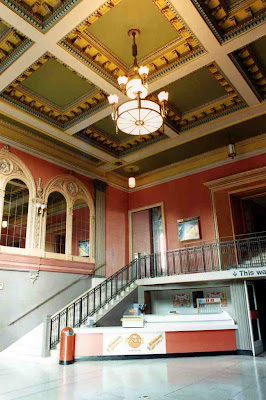 |
| Rear foyer - sweets, hot dogs and Kia-ora |
 |
| The entire circle became Granada 1. My favourite seat was at the end of the row in front of the divider. |
Access to Granada 2 and 3 was through the doors at the back of the foyer. These smaller cinemas were for re-releases, arthouse and horror films. By arthouse I mean soft porn, and by soft porn I mean really unfunny sex comedies.
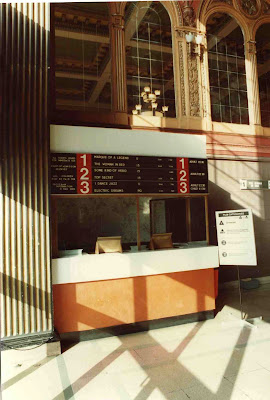 |
| Foyer ticket booth - later removed for the entrance to Options bar |
On a Saturday night, it was an extra treat to see that the 'coming soon' posters had been replaced, so we'd get a sneak peak at was coming the following Sunday.
Granada 1 and part of the neighbouring site joined to become Options nightclub in 1987. Another tiny cinema screen appeared, to make up for the loss of Granada 1. It was accessible from the top of the left hand stairs in the foyer.
But it closed as a cinema in 2002. A whole section of the exterior remains recognisable. It's currently a nightclub called Oceana. I should really go in and snoop around to see what's left besides the foyer. I took this photo in 2011.
Visit here for more of Dusashenka's superb set of photos for the Granada Kingston, including the projection booth, on Flickr.
More information on the Granada Kingston at Cinema Treasures.
You're encouraged to visit Dusashenka's massive Flickr site. He's posted his father's collection of photos of old cinemas from all over the country and I'm so very grateful to him. But please respect his photo collection and not use any of them without permission.
Cinema Treasures - database of cinemas past and present. Be sure to check the readers' comments under the main text - they often contain links to more photographs.
My look at what was different about movie-going in the 1970s - double-bills, intermissions, Film Review magazine...
Ewell and Esher cinemas in the 1970s.
Wimbledon cinemas in the 1970s.
June 10, 2013
THE RETURNED - now showing on Channel 4
Just a quick, late reminder that the superbly-made creepy French drama The Returned has started this week on Channel 4. Eight one-hour episodes charts the startling return of a group of dead inhabitants of a remote French village. Technically they're zombies, but they look human enough and walk and talk normally.
Each family deals with the sudden return of a dead relative in a different way, each of them causing their own problems, not to mention that a series of killings has resumed in the village...
Beautifully filmed, subtly judged performances, music from Mogwai and a fresh take on the undead. Adult, occasionally violent, often sexual, the quality of the series has obviously won over Channel 4 into showing a programme from overseas with English subtitles for the first time in twenty years.
In the UK, you can catch up with the first episode on 4OD.
The Returned is known as Les Revenants in France and is a reimagining of an earlier French film from 2004. Full details and a look at the failed American pilot are here in my guide to all things Revenants.
June 08, 2013
JACK THE RIPPER (1959) - the impressive continental version
JACK THE RIPPER
(1959, UK)
Differences in censorship between Britain and France
I've been using Horrors of the Black Museum (1959) as a benchmark of 1950s censorship. The outlandish murder weapons would suit seventies slasher movies, but while the methods are grisly, the violence is mostly implied and offscreen. The same year, another small independent production was also challenging the censor's rules on sex and violence. Jack The Ripper gives us timely insight into what was allowed in Britain, and how much more was allowed 'on the continent', before the swinging sixties had swung their first swing.
X-Cert is a new book that looks at the less talked about X-rated independent horror films of the fifties and sixties. While most of these horror films were familiar, the depth of research about their problems with the censors is invaluable. It made me take a second look at this early depiction of Jack The Ripper, author John Hamilton noting that it was the first film to actually portray Jack and his deeds directly. Many films had alluded to the story, notably Hitchcock's The Lodger (1927), but this is an (approximate) restaging of the original events. But the British censor was extremely watchful, even when it was only a script, and would have instructed the producers what would and wouldn't be acceptable in British cinemas before they'd even filmed a foot.
That didn't stop them from shooting more explicit scenes for the film's distribution in France. X-Cert demonstrates with some choice screengrabs the astonishing differences between the British and 'continental' versions of Jack The Ripper. Even in 1959, France allowed more violence during each murder and far more nudity throughout. With an old TV recording of the British film, and luckily the uncut French version on YouTube under the title Jack l'Éventreur, I could compare them for myself.
Jack The Ripper hadn't impressed me at all before. The portrayal of the murders dilute the original crimes to nothing more than muggings, and I was judging it on a 4:3 TV screening which renders much of the action cramped and confusing, tightened from its original widescreen. The French version on YouTube looks like 1.85 widescreen, roomier at the sides and showing off the carefully-framed cinematography admirably.
 |
| French DVD - cramped 1.33 framing and it's the censored version |
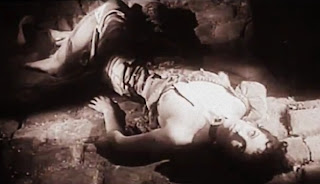 |
| Continental version on YouTube - sepia, widescreen, uncensored |
It's less low-budget than I'd remembered. The sets look good, my only quibble being that the East End of London should have been far, far busier. The cast is excellent, though largely unknown, and the investigating detectives are inexplicably American.
The French version lengthens each murder scene, showing more of the nasty knife. The bawdiness in the local music hall has been completely reshot so that many of the dancers are walking around topless. The amount of nudity in the dressing room scene makes Ken Russell look positively restrained. Note that the Ripper isn't hunting prostitutes, but music hall dancers. Any references to prostitution would be even more scandalous.
To add to all the possible variations, there's also an American version with a whole new soundtrack by a different composer. While I believe the violence and nudity are again missing, the final scene includes a single shocking shot added in colour! This scene is also currently on YouTube. More about the US version here.
The French DVD Jack L'Eventreur appears to be cropped horizontally to 1.33 full frame, but with English audio. The French DVD is reviewed here - in French - with screengrabs. But as you can see from the two comparison screengrabs above, the YouTube version demonstrates that a widescreen presentation could reveal far more of the frame at the sides. The screengrabs in the DVD review infer that ironically it's a release of the censored UK version!
An Italian DVD release, Jack Lo Squartatore, is 16:9 anamorphic widescreen but the composition now appears vertically tight, favouring too much headroom, indicating that 1.66 could be the ideal framing. The English audio track is sharper than the Italian! The transfer isn't clear but not perfect, possibly an analogue source, but the censor cuts are added as an extra, in even poorer condition.
A definitive DVD release would need a reframed transfer and some restoration. But this is just as scary and as much fun as many of the Ripper movies we've seen since.
More lobby cards and posters from this early Jack the Ripper here.
You can buy the book 'X-Cert - The British Independent Horror Film: 1951-1970' here.
Subscribe to:
Comments (Atom)











